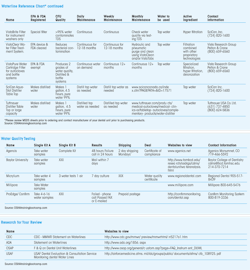Hidden Water Danger
What you need to know about your health and water lines
by Patricia Pine, RDH
Consider reading: Fighting Bioburden With Antimicrobial Textiles in Dental Uniforms
http://www.dentistryiq.com/articles/2013/01/fighting-bioburden-with-antimicrobial-textiles-in-dental-uniforms.html
Consider reading: A killer among us: deadly CRE bacteria
http://www.dentistryiq.com/articles/2012/12/a-killer-among-us-deadly-cre-bacteria.html
Consider reading: Study: Bib clip contamination remains after disinfection
http://www.dentistryiq.com/articles/2012/08/study-bib-clip-contamination-remains-after-disinfection.html
Who doesn't love the idea of a good vacation: breaking out of routine surroundings and getting away from the humdrum of everyday life? Some friends of mine named Bill and Carol decided to take a 10-day vacation. They planned to drive and were looking forward to investigating different architectural surroundings along the way to their destination. Bill and Carol were not into exotic getaways; a change of scenery and a chance to relax was all they needed. It was the perfect opportunity to spoil each other while enjoying a pause from their busy work schedules.
A driving trip meant packing the car with suitcases, a cooler full of drinks, fresh fruit, and of course, a map and GPS. Their trip started with an expectation of the great escape. Traveling via car was wonderful, viewing unknown buildings, the flat plains of the Midwest, and traveling south from Chicago to warmer weather for a week of R&R. Traveling 10 hours to any destination can exhaust anyone. It was late, and time to check into a hotel. Reaching their hotel destination, they entered the lobby for a typical routine check-in. When entering the assigned room, they both smelled a damp mildew odor. The air conditioner was on and the room was cool. An odor was apparent and not pleasant. They did not want to smell this obvious moldy smell all evening. The woman at the front desk assured Carol that everything would be fine. She stated that maintenance would turn the air conditioner on high and spray the room with special deodorizer and the problem would be taken care of. They requested another room but one was not available. Since they really didn’t have a choice, their luggage and cooler in tow, they decided to accept the spray. Finally, the odor dissipated and they were relaxing. They were ready to enjoy some free time.
The week was wonderful. The vacation was just enough to revive their motivation while igniting their love for life. (Vacations are always too quick.) During the last few days of vacation, Bill started to cough and was feeling ill. He had symptoms of a typical upper respiratory infection. By the time they reached home, Bill was getting worse. He had a headache, joint pains, aching muscles, loss of energy, and a fever of 104. Bill then developed gastrointestinal symptoms. Bill and Carol felt he must have caught a flu bug while on vacation. As the day continued, so did Bill’s symptoms. He began coughing up blood. They knew he was getting worse so they went to the local emergency room. The doctors examined him and found that his lungs were making a crackling sound. By this time, Bill could barely keep his eyes open and had chronic pain. The doctors began to ask numerous questions.
In the meantime, antibiotics were administered immediately, and the doctors remained very concerned. They requested a urine test and many other tests. They were puzzled. As time went by and test results returned, doctors grew alarmed. This was not a typical upper respiratory infection – this was Legionnaire’s disease, an acute respiratory infection caused by the Legionella bacteria.
Bill’s upper respiratory symptoms, which they thought were harmless, were actually deadly.
Bill was in the hospital for seven days. The doctors had prescribed multiple antibiotics. On day eight, Bill was released from the hospital. When preparing to return home, Bill passed out in the shower of the hospital and died due to Legionellosis disease. This was a shock to all.
The Centers for Disease Control and Prevention (CDC) called this a public health disease due to the fact that it was caused from a contaminated public water source.
In fact, after researching the hotel’s air conditioner, they discovered that it was the cause of Bill’s fatal disease. The smell of mold and mildew was caused by water from the air conditioner unit. It was discovered that the air conditioner dripped water along the carpet on the floor, which also was contaminated with mold, mildew, and Legionella pathogens. Turning the air conditioner to high spread the air mist swiftly throughout the room in which they slept.
A much needed vacation, enjoying a week away, turned deadly because of lack of maintenance of air conditioner filters and water lines. Could this happen to you?
Dentistry continues to be challenged on infection control protocol and guidelines from the CDC and ADA. In February 2012, an 82-year-old woman died in Italy after she contracted Legionnaires’ disease from the water lines in her dentist’s office. Scientists determined the source of the woman’s illness, since the woman left her home only twice to visit her dentist. Water testing in both her home and dental office discovered bacteria that caused Legionnaires’ disease in the woman’s dental office. Water lines that carry city water to a variety of chairside devices used during patient care were the culprit.
From July 16 through August 15, 2012, a Chicago hotel reported eight people contracted the flulike Legionnaires’ disease from possible water sources such as the pool, hot tub, and fountain areas. Eight guests were affected, including two deaths. This disease is not transmitted person to person. The culprit again is Legionnaires’ disease, present in a water source.
The connection between hotels, pools, and dental unit water lines is water, biofilm, compromised health, thin tubing, and routine maintenance. People’s lives depend on professionals from every occupation to maintain equipment with a water source.
Several items in dentistry need consideration: metal water syringe tips cannot be cleaned from the inside, so disease can be lurking within metal syringe tips. TotalCare and several other companies have created single-use disposable tips that work as well as metal. Seal-Tight syringe tips, from TotalCare, allow drying the area without a mist of water spray. Dental personnel sit chairside eight hours a day, so their health is at risk as long as water lines are not maintained.
What type of mask is being worn? Masks are single-use only and must be fluid resistant. Masks are now available that can be customized to conform to one’s face with breathability. Studies have shown that multiple types of bacteria lurk on chain or plastic bib holders used to protect patients’ clothing. These bib holders, when wet, can become tainted with contaminated droplets. Bib-Eze, disposable bib holders from DUX Dental, are available to remove this bacterial source. Dental manufacturers are willing to send samples and share their knowledge on products to help dental professionals improve patient care and keep patients safe.
For years, the dental community has been challenged on the concern of water lines in the United States. The American Dental Association states the U.S. has very stringent water line infection control standards. The challenge is keeping the biofilm and bacterial count low in order to prevent infectious disease. The ADA recommends that water lines contain no more than 200 CFUs (colony forming units) of bacteria per milliliter of water.
Biofilm is the perpetrator throughout the country. In dentistry, the concern is the biofilm within the tiny thin tubing that carries water to the dental unit. The combination can create havoc for both maintenance and use of the unit. It seems that we hear about biofilm more and more. Oral biofilm is the menace that can cause periodontal disease with an imbalance of bacteria. Biofilm is the cause of many medical implants’ failure. MRSA and osteonecrosis are both linked to microbial biofilms. They form thin, slimy layers that accumulate inside the thin tubing of dental units. The dental tubing delivers water to handpieces, water-air syringes, ultrasonic scalers, and piezo units. Organisms accumulate inside the thin tubing that delivers the water to the patient’s oral cavity and are also found in aerosols throughout the operatory. Exposure to these microbes does not mean that an individual will get an infection or a disease. However, if a patient’s immune system is compromised for any reason including age, smoking, heavy drinking, and being a transplant or cancer patient, he or she may have a harder time fighting off these invading germs. This is why the CDC has set dental water quality standards of no greater than 500 CFUs in water used for patient care to protect both patients and dental staff. Ask yourself, what are the current CFUs in your practice’s water lines?
There can be some confusion regarding what product to use, how to use it, and if it will work in all dental units, as well as when to test, and how to maintain dental waterlines. There are products available that can save time and money. With that said, maintenance and testing is continual. Sterisil has developed products that last approximately one year and produce water with less than 10 CFU/mL from their antimicrobial water bottle and straw. It’s recommended that the water is shocked before use. Both of these products reduce clinician concern about lurking diseases. Micrylium has developed a product called Lines, which is chlorhexidine based and can be used during ultrasonic scaling while reducing the bacterial CFUs. DentaPure developed water line filters and straws to reduce the microbial load in dental units. Hu-Friedy has both water line cleaner and shock treatment to assist the dental community to adapt to the recommended guidelines. There are many to choose from, so decide which product fits your practice’s needs and your team’s time limitations.
The strategies below will assist offices in creating a safe, healthy environment for patients and staff:
Dentistry has a plethora of water line products available. Each product is different in what it is used for. It is very important to understand if the product is used for water lines or for water itself. I developed a “Water Line Research Chart” for dental professionals as an overview of products that are available. There are daily, weekly, and monthly maintenance needs. Please visit www.OSHAtrainingbootcamp.com to download the chart. I invite you to view the “5 Strategies for Water Line Health” webinar at the same web address above. I am happy to assist in any questions or confusion that dental water lines create.
For more information on Legionnaires’ disease, visit http://www.osha.gov/dts/osta/otm/legionnaires/faq.html.
This is a true story. Bill and Carol’s names are changed to protect their privacy. It is sad that this vacation had such a tragic ending. We, as dental professionals, need to stay abreast of the regulations and preventive measures to avoid these types of situations and save lives. Be aware to stay healthy. When vacationing, I recommend if you smell mold or mildew, run, do not walk, out of the facility. It just may save your life!
References
Statement on dental unit water lines www.ada.org
CDC – Medical & Dental Equipment Connected to Main Water www.cdc.gov/healthywater/other/medical/med_dental.html
Guidelines for Environmental Infection Control in Health-Care Setting www.cdc.gov/mmwr/pdf/rr/rr5210.pdf
Guidelines for Infection Control in Dental Health Care Setting – MMWR 2003
http://www.cdc.gov/mmwr/preview/mmwrhtml/rr5217a1.htm
Dental unit water lines issue www.osap.org/?page=issues_DUWL
Advancing infection control in dental care settings – Abstract
http://jada.ada.org/content/143/10/1127.full.pdf+html
Identification of microbial biofilms in osteonecrosis of the jaws secondary to bisphosphonate
http://www.ncbi.nlm.nih.gov/pubmed/18355603
Biofilm formation and MRSA http://www.mrsamedical.com/mrsabiofilms.htm
Legionnaires’ disease http://www.mayoclinic.com/health/legionnaires-disease/DS00853/DSECTION=causes
Patricia M. Pine, RDH, is a dental hygienist, international speaker, and creates programs for dental professionals. She may be reached at [email protected] for consulting and presenting opportunities, or visit her website at www.OSHAtrainingbootcamp.com.
Strategies for maintaining dental unit water lines
- Test your water lines. Get a baseline; know what you’re working toward. Create a need for water line maintenance. If you are using a product now, is it working? Keep your CFU water line report in the OSHA office manual. Many different companies are available for testing. Testing in-office is available but time-consuming, and needs to be completed according to specific directions. Is the time available
- Check with the manufacturer of your dental unit. Ask what product is recommended and why. What does this product do? How do we know it is working? Look up the MSD sheet – check the product for harmful effects to people or animals.
- Decide as a team what product should be used. This is a team decision.
- Is the product EPA registered? What water type is recommended – tap water or distilled
- Create standard operating procedures on maintaining water lines for your practice. This is a training guide for all current, new, or temporary employees that are assisting in patient care. Water line health is very important – maintenance is a must. This is nonnegotiable.
Past RDH Issues




